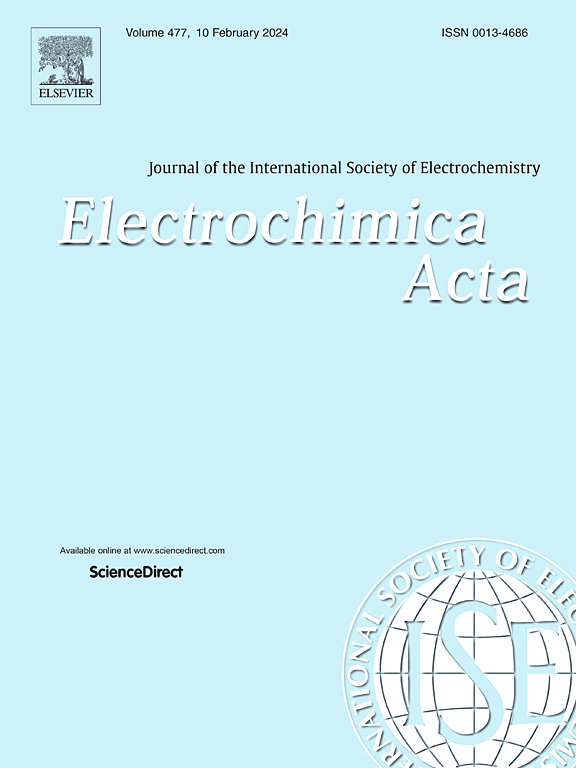mOMe-Ir-PI/MWCNTs@PDA/GCE传感器的构建及斑马鱼胚胎嘌呤的检测
IF 5.6
3区 材料科学
Q1 ELECTROCHEMISTRY
引用次数: 0
摘要
嘌呤代谢异常可导致氧化应激和内皮功能障碍,增加痛风和心血管疾病等疾病的风险,随后可能引发各种生理功能障碍。因此,快速、灵敏地检测嘌呤代谢异常对于相关疾病的早期诊断和预防至关重要。斑马鱼由于其与人类的高度遗传相似性和其胚胎的透明性,便于观察,已成为代谢、遗传和毒理学研究中流行的模式生物。在这项研究中,我们开发了一种基于mOMe-Ir-PI/MWCNTs@PDA/GCE的新型电化学传感器,用于灵敏地检测嘌呤分子。利用该方法分析了斑马鱼胚胎的电化学行为,并将电化学信号与X/G和HX/A进行了关联。通过对斑马鱼胚胎不同发育阶段嘌呤代谢的研究,我们发现从卵裂期到体体形成阶段,降解酶的活性增加,导致嘌呤氧化降解增强,代谢途径激活。这导致嘌呤含量下降,电化学信号下降。相反,从体体形成阶段到孵化阶段,细胞分化、组织形成和器官发育加快,导致参与能量代谢和生物合成的嘌呤增加,这体现在电化学信号的上升。该研究首次应用电化学方法检测斑马鱼胚胎在不同发育阶段的嘌呤代谢,从而深入了解嘌呤代谢在早期生命发育中的作用。本文章由计算机程序翻译,如有差异,请以英文原文为准。

The Construction of The mOMe-Ir-PI/MWCNTs@PDA/GCE Sensor and Purine Detection in Zebrafish Embryos
Abnormal purine metabolism can result in oxidative stress and endothelial dysfunction, heightening the risks for conditions such as gout and cardiovascular disorders, which may subsequently trigger various physiological dysfunctions. Thus, the rapid and sensitive detection of metabolic abnormalities in purines is crucial for the early diagnosis and prevention of related diseases. Zebrafish has emerged as a popular model organism in metabolic, genetic, and toxicological studies due to its high genetic similarity to humans and the transparency of its embryos, facilitating observation. In this study, we developed a novel electrochemical sensor based on mOMe-Ir-PI/MWCNTs@PDA/GCE to detect purine molecules sensitively. Using this method, we analyzed the electrochemical behavior of zebrafish embryos, correlating the electrochemical signals with X/G and HX/A. Investigating purine metabolism in zebrafish embryos across different developmental stages, we found that from the cleavage stage to the somite formation stage, the activity of degrading enzymes increased, leading to enhanced purine oxidative degradation and the activation of metabolic pathways. This resulted in a decline in purine content, observed as decreasing electrochemical signals. Conversely, from the somite formation stage to hatching, cell differentiation, tissue formation, and organ development accelerated, leading to an increase in purines involved in energy metabolism and biosynthesis, which was reflected in rising electrochemical signals. This study represents the first application of electrochemical methods for detecting purine metabolism in zebrafish embryos throughout various developmental stages, thus providing insights into the role of purine metabolism in early life development.
求助全文
通过发布文献求助,成功后即可免费获取论文全文。
去求助
来源期刊

Electrochimica Acta
工程技术-电化学
CiteScore
11.30
自引率
6.10%
发文量
1634
审稿时长
41 days
期刊介绍:
Electrochimica Acta is an international journal. It is intended for the publication of both original work and reviews in the field of electrochemistry. Electrochemistry should be interpreted to mean any of the research fields covered by the Divisions of the International Society of Electrochemistry listed below, as well as emerging scientific domains covered by ISE New Topics Committee.
 求助内容:
求助内容: 应助结果提醒方式:
应助结果提醒方式:


